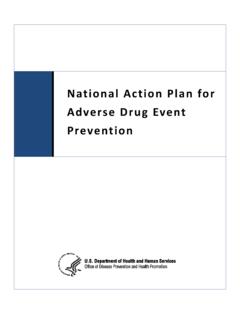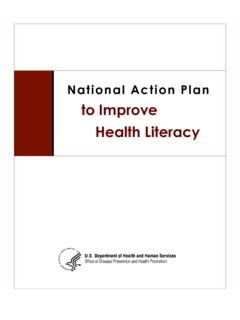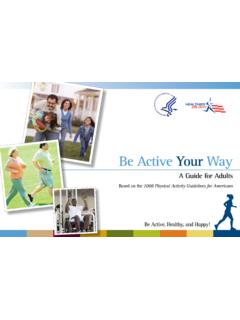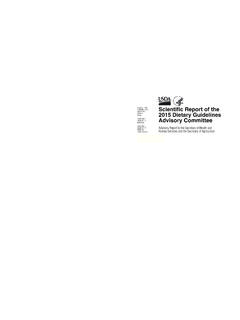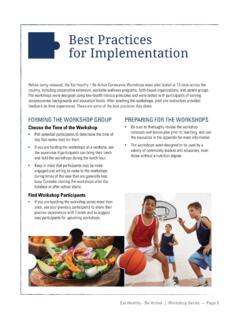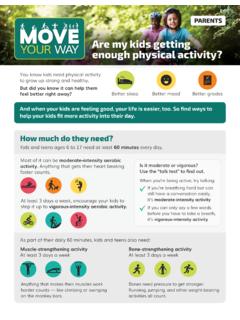Transcription of CHAPTER 7: INFLUENZA VACCINATION OF HEALTH CARE …
1 NATIONAL action plan TO PREVENT HEALTH care - associated infections : ROAD MAP TO ELIMINATION APRIL 2013 CHAPTER 7: INFLUENZA VACCINATION OF HEALTH care personnel I. INTRODUCTION HEALTH care personnel (HCP) can acquire INFLUENZA and transmit it to patients and other HCP. Many HCP provide care for or are in frequent contact with patients with INFLUENZA or patients at high risk for complications of INFLUENZA , and their involvement in INFLUENZA transmission is a long-standing ,2,3 INFLUENZA VACCINATION is effective and can prevent many illnesses, deaths, and losses in Expanding INFLUENZA vaccine use among HCP is a high priority.
2 Achieving and sustaining high INFLUENZA VACCINATION coverage among HCP is intended to help protect HCP and their patients and reduce disease burden and HEALTH care costs. Until recently, VACCINATION coverage among HCP has been well below the national Healthy People 2010 target of 60%5 (see Figure 2), but preliminary data show that 63% of HCP reported receiving seasonal INFLUENZA vaccine in 2010 2011 and 67% reported receiving the vaccine in 2011 ,7 1 Maltezou HC, Drancourt M. Nosocomial INFLUENZA in children. Journal of Hospital Infection 2003; 55:83-91. 2 Hurley JC, Flockhart S.
3 An INFLUENZA outbreak in a regional residential facility. Journal of Infection Prevention 2010; 11:58-61. 3 Salgado CD, Farr BM, Hall KK, Hayden FG. INFLUENZA in the acute hospital setting. The Lancet Infectious Diseases 2002; 2:145-155. 4 Wilde JA, McMillan JA, Serwint J, Butta J, O Riordan MA, Steinhoff MC. Effectiveness of INFLUENZA vaccine in HEALTH care professionals: a randomized trial. Journal of the American Medical Association 1999; 281:908-913. 5 Walker FJ, Singleton JA, Lu P, Wooten KG, Strikas RA. INFLUENZA VACCINATION of healthcare workers in the United States, 1989-2002.
4 Infection Control and Hospital Epidemiology 2006; 27:257-265. 6 Centers for Disease Control and Prevention. INFLUENZA VACCINATION Coverage Among HEALTH - care personnel United States, 2010-2011 INFLUENZA Season. Morbidity and Mortality Weekly Report (MMWR): 60:1073-1077. Available at 7 HEALTH care personnel Flu VACCINATION . Internet Panel Survey, United States, November 2011. August 24, 2012. 174 NATIONAL action plan TO PREVENT HEALTH care - associated infections : ROAD MAP TO ELIMINATION APRIL 2013 Figure 2.
5 Estimated INFLUENZA VACCINATION (Trivalent) Coverage, HEALTH care personnel Healthy People 2020 set a target of 90% coverage for HCP INFLUENZA Meeting this target will involve several challenges. The HEALTH care associated infections (HAIs) Increasing INFLUENZA VACCINATION Coverage Among HEALTH care personnel Working Group of the Federal Steering Committee for the Prevention of HAIs has been convened to identify and implement areas of strategic focus to increase immunization coverage of HCP and provide direction for future departmental resources in this initiative. The working group s goals are to promote increased HCP INFLUENZA immunization coverage by working with other HHS operating and staff divisions and nonfederal partners and to identify approaches to reaching the 90% target for Healthy People 2020.
6 The group also proposes an interim target of 75% VACCINATION coverage among HCP by , 10 It is important to note that although the working group is focused on increasing INFLUENZA VACCINATION of HCP, such VACCINATION represents only one component of a comprehensive strategy for preventing INFLUENZA transmission in HEALTH care 8 Healthy People 2020 Immunization and Infectious Disease Objectives, IID , available at INFLUENZA VACCINATION of Healthcare personnel Working Group Meeting Notes, meeting of June 4, INFLUENZA VACCINATION of Healthcare personnel Working Group Meeting Notes, meeting of June 4, 2010.
7 11 Centers for Disease Control and Prevention. Prevention Strategies for Seasonal INFLUENZA in Healthcare Se t t i n g s . Available at Accessed October 20, 2010. 175 NATIONAL action plan TO PREVENT HEALTH care - associated infections : ROAD MAP TO ELIMINATION APRIL 2013 II. BACKGROUND A. Definition of HCP For this CHAPTER , we have decided to use the Centers for Disease Control and Prevention s (CDC s) Healthcare Infection Control Practices Advisory Committee (HICPAC) and the Advisory Committee on Immunization Practices (ACIP) HCP definition because of its inclusiveness and the involvement of multiple stakeholders in its development.
8 By this definition, HCP are all paid and unpaid persons working in HEALTH care settings who have the potential for exposure to patients or to infectious materials, including body substances, contaminated medical supplies and equipment, contaminated environmental surfaces, and contaminated HCP might include physicians, physician assistants, nurses, nursing assistants, therapists, technicians, emergency medical services personnel , dental personnel , pharmacists, laboratory personnel , autopsy personnel , students and trainees, contractual staff not employed by the HEALTH care facility, and persons ( , clerical, dietary, housekeeping, laundry, security, maintenance, and billing personnel , and volunteers) not directly involved in patient care but potentially exposed to infectious agents that can be transmitted to and from HCP and patients.
9 Settings in which HCP may work include acute care hospitals, long-term care facilities (LTCFs), nursing homes, skilled nursing facilities, rehabilitation centers, home HEALTH agencies, physicians offices, urgent care centers, outpatient clinics, dialysis facilities, and emergency medical services. HCP include hospital and office staff, contract workers, volunteers, trainees, and other types of personnel . Thus, the types of work done, levels of institutional oversight, and employment mechanisms are diverse. B. INFLUENZA Morbidity, Mortality, and Costs The morbidity, mortality, and economic impact from INFLUENZA each year can be substantial, as the following statistics demonstrate: Each year, between 5% and 20% of the population becomes ill with Between 1976 and 2007, annual INFLUENZA - associated deaths have ranged from about 3,000 to about 50, On average, about 200,000 hospitalizations due to INFLUENZA occurred each year between 1979 and 12 Adapted from: Pearson ML, Bridges CB, Harper SA.
10 INFLUENZA VACCINATION of HEALTH - care personnel : Recommendations of the Healthcare Infection Control Practices Advisory Committee (HICPAC) and the Advisory Committee on Immunization Practices (ACIP). Morbidity and Mortality Weekly Report (MMWR) 2006; 55:1-16. Available at 13 Centers for Disease Control and Prevention:Questions and Answers, Seasonal INFLUENZA . Available at Centers for Disease Control and Prevention. Estimates of deaths associated with seasonal INFLUENZA United States, 1976-2007. Morbidity and Mortality Weekly Report (MMWR) 2010; 59:1057-62. Available at Thompson WW, Shay DK, Weintraub E, et al.
